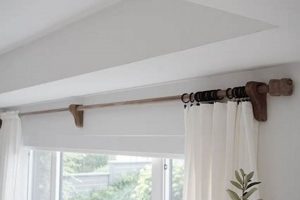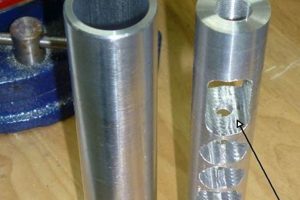A handcrafted, compact camping trailer, often characterized by its distinctive curved profile, allows individuals to construct personalized recreational vehicles. These structures frequently incorporate sleeping quarters and a basic kitchenette, representing a cost-effective and customizable alternative to commercially manufactured campers. The act of building such a trailer facilitates hands-on engagement with design and construction principles.
Engaging in such projects yields several advantages, including significant cost savings, tailored design features to suit individual needs, and the satisfaction of creating a functional and aesthetically pleasing travel companion. Historically, similar endeavors reflect a tradition of self-sufficiency and resourcefulness, empowering individuals to independently address their recreational needs. The compact nature of the resulting trailer also contributes to ease of towing and storage.
The subsequent sections will address crucial aspects of the building process, including chassis selection, framing techniques, electrical system integration, interior finishing, and relevant safety considerations for constructing a personalized camping trailer. Detailed guidance will be provided to assist in each phase of the project.
Construction Advice for a Compact Camping Trailer
The following are considerations critical to successful construction of a compact camping trailer, ensuring structural integrity, safety, and functional utility.
Tip 1: Chassis Selection: Employ a robust chassis with a weight rating exceeding the anticipated total weight of the finished trailer and its contents. Thoroughly inspect the chassis for rust or structural damage prior to commencing construction. Consider axle placement for optimal weight distribution and towing stability.
Tip 2: Framing Material: Utilize lightweight, durable materials such as aluminum or treated lumber for the frame. Ensure proper joinery techniques, such as welding or reinforced screw connections, to maintain structural rigidity. Implement diagonal bracing to resist racking forces during transit.
Tip 3: Weatherproofing: Apply a high-quality sealant to all seams and joints to prevent water intrusion. Proper ventilation is crucial to minimize condensation and prevent mold growth within the trailer. Invest in durable, weather-resistant exterior cladding materials.
Tip 4: Electrical System: Employ a properly grounded electrical system conforming to relevant safety codes. Utilize appropriately sized wiring and circuit protection devices to prevent overloads. Consider incorporating a battery system and solar charging capabilities for off-grid operation.
Tip 5: Interior Layout: Optimize interior space utilization through efficient design and storage solutions. Consider ergonomics and accessibility when planning the layout of sleeping quarters, kitchenette, and storage compartments. Prioritize weight distribution when positioning interior components.
Tip 6: Lighting System: Carefully plan your interior lighting system. Selecting efficient LED options will conserve energy and extend battery life, while considering multiple light sources can provide both ambient and task lighting.
Tip 7: Ventilation: Adequate airflow is paramount within the trailer. Install vents strategically to promote cross-ventilation, reduce moisture build-up, and enhance comfort during varying weather conditions.
Tip 8: Safety Features: Install smoke detectors, carbon monoxide detectors, and a fire extinguisher. Consider adding backup safety measures such as additional trailer lights or reflective safety tape.
Adhering to these guidelines will contribute to a structurally sound, weather-resistant, and functionally efficient compact camping trailer suitable for diverse recreational applications.
The subsequent sections will explore specific construction techniques and material selections in greater detail.
1. Chassis Integrity
Chassis integrity is fundamental to the safety and longevity of any handcrafted camping trailer. The chassis, serving as the structural foundation, bears the entire weight of the trailer body, internal components, and cargo during transport. Compromised chassis integrity, resulting from factors such as corrosion, fatigue, or improper modification, can lead to catastrophic structural failure while in transit, posing significant safety risks to both the occupants and other motorists. For example, a trailer with a rusted or weakened chassis may experience axle separation or complete frame collapse under load, especially on uneven terrain or during high-speed maneuvers.
The importance of chassis integrity is particularly pronounced in projects involving the repurposing of existing utility trailer frames. These frames, often sourced from older or salvage vehicles, may exhibit pre-existing structural weaknesses that necessitate thorough assessment and reinforcement. Failure to adequately address these weaknesses can compromise the overall safety and structural integrity of the finished camping trailer. Properly evaluating a chassis can involve professional inspection, load testing, and verification of compliance with relevant safety standards. Strengthening processes may involve welding additional support members, replacing corroded sections, and applying protective coatings to prevent future degradation.
In summary, prioritizing chassis integrity is non-negotiable in the construction of a compact camping trailer. A robust and well-maintained chassis is the bedrock upon which the entire structure rests, ensuring safe and reliable operation for years to come. Neglecting this aspect can lead to dire consequences, underscoring the practical significance of meticulous inspection, reinforcement, and adherence to established safety protocols. The structural integrity of the chassis is directly proportional to the safety and overall success of the recreational vehicle project.
2. Frame Robustness
Frame robustness directly influences the structural integrity and longevity of a handcrafted camping trailer. The frame, serving as the skeletal support, withstands dynamic stresses during transit, including torsional forces, wind resistance, and road vibrations. A compromised frame, characterized by inadequate material selection, improper joinery, or insufficient bracing, increases the risk of structural failure, leading to compromised safety and diminished functionality. For example, a trailer frame constructed from untreated lumber may be susceptible to rot and insect infestation, resulting in weakening of the structure over time. Similarly, a frame with poorly executed welds or insufficient bracing may experience cracking or deformation under stress, particularly when traversing uneven terrain or experiencing high wind loads.
Frame robustness is particularly critical in projects where weight optimization is a primary
concern. Lightweight framing materials, such as aluminum or thin-gauge steel, require careful design and construction techniques to achieve adequate strength and stiffness. Proper joinery methods, such as welding or the use of gussets, are essential for distributing stress and preventing localized failures. Bracing, often achieved through the strategic placement of diagonal members, provides additional resistance to racking forces and helps maintain the frame’s overall geometry. In practical applications, a well-designed and constructed frame will exhibit minimal flex or deformation under load, ensuring a stable and secure platform for the trailer body and its contents. This, in turn, contributes to improved handling and reduced wear and tear on other components, such as the suspension and axles.
In summary, frame robustness represents a critical design consideration in the construction of a compact camping trailer. Achieving adequate strength and stiffness requires careful material selection, precise joinery, and strategic bracing. Neglecting frame robustness can lead to premature structural failure, compromising safety and reducing the overall lifespan of the trailer. By prioritizing robust frame construction, builders can ensure a durable and reliable recreational vehicle capable of withstanding the rigors of travel and extended use.
3. Weather Sealing
Weather sealing is a crucial element in the design and construction of any compact camping trailer, directly impacting its longevity, comfort, and overall utility. Effective weather sealing protects the trailer’s interior from moisture intrusion, preventing structural damage, mold growth, and discomfort for occupants.
- Seam and Joint Protection
The sealing of seams and joints is paramount to preventing water ingress. All points where different materials meet, such as the roof-to-wall interface or window and door installations, require meticulous sealing. This typically involves the application of high-quality, flexible sealants designed for exterior use. Failure to adequately seal these areas can result in water seeping into the trailer’s structure, leading to rot, corrosion, and delamination of materials.
- Roofing Material Selection and Installation
The roofing material must be inherently waterproof and properly installed to shed water effectively. Options include rubber roofing, coated canvas, or metal roofing, each with its own set of installation requirements. Overlapping seams must be carefully sealed, and the roof should be sloped to facilitate drainage. Improperly installed roofing can lead to leaks, resulting in significant damage to the trailer’s interior and structural components. For example, a poorly sealed roof vent can introduce significant amounts of water during rainfall.
- Window and Door Sealing
Windows and doors represent potential entry points for water and air infiltration. Proper sealing involves the use of weatherstripping around the perimeter of the openings, as well as sealing the frames to the trailer’s body. Adjustable latches and hinges can ensure a tight seal, even as the trailer experiences vibration and movement during transport. Neglecting window and door sealing can result in drafts, water damage, and increased energy consumption for heating and cooling.
- Underbody Protection
The underbody of the trailer is susceptible to moisture and road debris. Applying a protective coating, such as rubberized undercoating or sealant, can prevent corrosion and water damage. Sealing any openings or seams in the underbody is crucial for preventing water from splashing up into the trailer’s floor and walls. Proper underbody protection extends the lifespan of the trailer’s structural components and helps maintain a dry and comfortable interior environment.
These facets of weather sealing are not merely aesthetic considerations but are fundamental to the long-term viability of a compact camping trailer. Effective weather sealing preserves the structural integrity, prevents health hazards, and enhances the overall enjoyment of the recreational experience. Therefore, meticulous attention to weather sealing during construction is essential.
4. Electrical Safety
Electrical safety is a paramount concern in the construction of any recreational vehicle, and compact camping trailers are no exception. The integration of electrical systems into such trailers presents unique challenges due to space constraints and the potential for exposure to outdoor elements. A thorough understanding of electrical principles and adherence to established safety codes are essential to prevent hazards such as electric shock, fire, and equipment damage.
- Wiring and Circuit Protection
Proper wiring techniques and circuit protection devices form the foundation of a safe electrical system. All wiring must be of appropriate gauge for the intended current load, and connections must be secure and properly insulated. Circuit breakers or fuses must be installed to protect against overloads and short circuits. For instance, improperly sized wiring can overheat and cause a fire, while the absence of circuit protection can lead to catastrophic equipment failure and potential harm to occupants. Compliance with relevant electrical codes is crucial to ensure safe and reliable operation.
- Grounding and Bonding
Grounding and bonding are essential for minimizing the risk of electric shock. All metal components of the trailer’s electrical system, including the chassis, must be properly grounded to provide a low-impedance path for fault currents. Bonding ensures that all metal parts are at the same electrical potential, reducing the likelihood of voltage differences that could cause shock. Failure to properly ground and bond the system can create hazardous conditions, particularly in wet or damp environments.
- GFCI Protection
Ground Fault Circuit Interrupters (GFCIs) provide critical protection against electric shock in areas where water is present, such as the kitchenette or near sinks. GFCIs monitor the current flow in a circuit and quickly interrupt the power if a ground fault is detected. This prevents electricity from flowing through a person who might be in contact with a live wire. Installing GFCIs in appropriate locations is essential for minimizing the risk of electric shock in a compact camping trailer.
- Battery and Charging Systems
If the trailer incorporates a battery system for off-grid power, careful attention must be paid to the charging system. Overcharging or improper charging can damage the battery and create a fire hazard. Charge controllers should be used to regulate the charging process and prevent overcharging. Additionally, batteries should be properly vented to prevent the accumulation of explosive gases. A well-designed and maintained battery and charging system is essential for safe and reliable off-grid power.
The integration of electrical systems into a self-constructed compact camping trailer necessitates a meticulous approach to safety. The principles outlined above, when diligently applied, contribute to the creation of a secure and functional electrical environment. Ignoring these considerations may expose individuals to considerable risks; therefore, careful adherence to established codes and best practices is crucial. For
DIY projects with an electrical component, consulting a qualified electrician is highly recommended.
5. Interior Ergonomics
Interior ergonomics, the science of designing workspaces to fit the user, assumes paramount importance within the confines of a self-constructed camping trailer. Given the typically limited spatial envelope of such structures, optimizing comfort, accessibility, and functionality becomes a critical design imperative. Effective ergonomic planning directly impacts user satisfaction, safety, and the overall enjoyment of the recreational experience.
- Sleeping Area Optimization
The sleeping area, often the dominant feature, requires careful consideration of mattress dimensions, headroom, and ingress/egress. Minimizing strain on joints and muscles during entry and exit is essential. For example, a platform height that is too low may necessitate excessive bending, while insufficient headroom can induce discomfort and a sense of claustrophobia. Solutions often involve custom-built platforms, strategically placed steps, and maximizing vertical space. A well-designed sleeping area promotes restful sleep and reduces the risk of musculoskeletal discomfort.
- Storage Solutions
Efficient storage design is fundamental to maximizing usable space and minimizing clutter. Ergonomic storage solutions prioritize accessibility, organization, and ease of use. For example, drawers should be equipped with smooth-gliding mechanisms and positioned at a comfortable reach. Vertical storage solutions, such as shelves and cabinets, should be configured to accommodate items of varying sizes and weights. Effective storage design prevents unnecessary bending, lifting, and reaching, reducing the risk of strain injuries and promoting a more organized and functional living space.
- Kitchenette Configuration
The kitchenette, often a compact area, requires careful attention to countertop height, sink placement, and appliance accessibility. Countertops should be at a comfortable working height to minimize back strain during food preparation. The sink should be positioned to allow for easy access and drainage. Appliances, such as stoves and refrigerators, should be securely mounted and easily accessible. A well-designed kitchenette promotes efficient workflow and reduces the risk of spills, burns, and other accidents.
- Lighting and Ventilation
Adequate lighting and ventilation contribute significantly to the comfort and usability of the interior. Proper lighting reduces eye strain and enhances visibility, particularly during tasks such as reading or cooking. Strategically placed windows and vents promote airflow and reduce moisture buildup, preventing condensation and improving air quality. Adjustable lighting fixtures and strategically positioned vents allow occupants to customize the environment to their individual preferences. Effective lighting and ventilation enhance the overall livability of the camping trailer.
The integration of ergonomic principles represents a crucial facet of effective design. A camping trailer constructed with careful attention to ergonomic considerations is far more likely to provide a comfortable, functional, and enjoyable recreational experience. Prioritizing user well-being through thoughtful design elevates the value and utility of the finished product.
6. Weight Distribution
Weight distribution is a critical factor in the design and construction of any compact camping trailer. The placement of weight within the trailer directly affects its towing stability, handling characteristics, and overall safety. Improper weight distribution can lead to dangerous swaying, reduced braking effectiveness, and even trailer rollover. In the context of “diy teardrop” projects, where designs are often customized and may deviate from established engineering principles, meticulous attention to weight distribution is particularly important. For example, a trailer with excessive weight concentrated at the rear may exhibit a tendency to fishtail at highway speeds, posing a significant risk to the driver and other vehicles. This is often seen when builders place a large water tank or battery bank behind the axle. Conversely, too much weight at the front can overload the tow vehicle’s rear axle, compromising steering control and potentially damaging the vehicle.
Practical application of weight distribution principles in “diy teardrop” construction involves several key considerations. First, the axle should be positioned such that approximately 60% of the trailer’s total weight rests ahead of the axle and 40% behind it. This configuration provides optimal stability and minimizes the risk of sway. Second, heavy items, such as batteries, water tanks, and propane cylinders, should be placed as close to the axle as possible. This reduces the leverage effect of these items and minimizes their impact on the trailer’s center of gravity. Finally, careful planning of interior layout is essential to ensure even distribution of cargo. Avoiding the concentration of heavy items on one side of the trailer is crucial to prevent uneven loading and potential instability. Consider, as a real-world example, placing the water tank and battery on opposite sides of the trailer, close to the axle, to balance their weight.
Understanding and implementing proper weight distribution techniques is not merely an academic exercise; it is a fundamental requirement for safe and enjoyable recreational travel. The challenges inherent in self-built designs demand a rigorous approach to weight management. By adhering to established guidelines and prioritizing balanced loading, builders can mitigate the risks associated with improper weight distribution and ensure the stability and safety of their compact camping trailer. In sum, Weight distribution is an integral element in “diy teardrop” construction, having a direct correlation to safety and towing performance. It requires careful planning, precise execution, and a commitment to adhering to established engineering principles.
7. Ventilation Adequacy
Ventilation adequacy represents a critical yet often underappreciated aspect of compact camping trailer design, significantly influencing occupant health, comfort, and the trailer’s structural integrity. Adequate ventilation mitigates moisture buildup, reduces the concentration of airborne contaminants, and helps regulate interior temperature. In the context of “diy teardrop” construction, where space is limited and design choices can greatly impact airflow, a well-planned ventilation system is paramount.
- Moisture Control
The control of moisture within a compact camping trailer is essential to prevent mold growth, wood rot, and corrosion. Occupants generate moisture through respiration, cooking, and washing. Inadequate ventilation allows this moisture to condense on interior surfaces, creating a breeding ground for mold and accelerating the deterioration of building materials. Strategically placed vents, roof fans, or cross-ventilation designs facilitate the removal of moist air, maintaining a dry and healthy interior environment. For example, a simple roof vent installed above t
he sleeping area can significantly reduce condensation buildup during colder nights. - Air Quality Management
Maintaining acceptable air quality within the confines of a “diy teardrop” requires effective ventilation to remove airborne contaminants. Cooking fumes, combustion byproducts from heaters, and outgassing from construction materials can all contribute to poor indoor air quality. Ventilation systems that introduce fresh air and exhaust stale air help dilute these contaminants, improving occupant health and comfort. Consider a vent located near the cooking area to expel fumes generated during food preparation, or a low mounted intake vent paired with a roof exhaust fan for a natural convection current.
- Temperature Regulation
Ventilation plays a crucial role in regulating the interior temperature of a compact camping trailer, particularly in warm climates. By promoting airflow, ventilation systems can help dissipate heat buildup, reducing the need for air conditioning and improving occupant comfort. Cross-ventilation, achieved by opening windows or vents on opposite sides of the trailer, encourages airflow and facilitates cooling. Strategically placed awnings or reflective materials can further reduce solar heat gain, minimizing the burden on the ventilation system. High temperatures without proper ventilation can be extremely uncomfortable and can make a camping trip unmemorable for the wrong reasons.
- Condensation Prevention
Condensation is a common challenge in compact camping trailers, particularly in humid environments or during temperature fluctuations. Warm, moist air inside the trailer comes into contact with cooler surfaces, causing moisture to condense and accumulate. Proper ventilation helps prevent condensation by removing moisture-laden air and promoting airflow around interior surfaces. Ensuring adequate insulation further reduces condensation by maintaining warmer surface temperatures. Preventing condensation ensures the comfort of the interior and helps prevent damage over time.
In essence, adequate ventilation is not merely an optional amenity, but a fundamental requirement for a safe, healthy, and comfortable compact camping trailer. Careful planning and execution of the ventilation system are essential to mitigate moisture buildup, maintain air quality, regulate temperature, and prevent condensation. This is why careful design and well thought out ventilation is critical when building a teardrop trailer.
Frequently Asked Questions Regarding “diy teardrop” Construction
The following questions address common concerns and misconceptions pertaining to the design, construction, and safe operation of self-built compact camping trailers.
Question 1: What essential tools are required for building a “diy teardrop”?
Construction necessitates a comprehensive toolkit including, but not limited to: circular saw, jigsaw, drill/driver, measuring tape, level, square, clamps, and various hand tools. Welding equipment may be required depending on the chassis and frame construction method. Safety gear, including eye protection, hearing protection, and gloves, is mandatory.
Question 2: What are the primary considerations for selecting a suitable chassis for a “diy teardrop”?
Chassis selection hinges on weight capacity, structural integrity, and compatibility with the intended dimensions of the trailer. A robust chassis with a sufficient load rating, exceeding the projected total weight of the finished trailer, is essential. Thorough inspection for rust or structural damage is imperative.
Question 3: What materials are recommended for constructing the frame of a “diy teardrop”?
Frame construction typically involves lightweight, durable materials such as aluminum, steel, or treated lumber. Aluminum offers corrosion resistance and a high strength-to-weight ratio. Steel provides exceptional strength but requires rust protection. Treated lumber offers a cost-effective option, but must be properly sealed and protected from the elements.
Question 4: How should electrical systems be integrated into a “diy teardrop” to ensure safety?
Electrical system integration demands strict adherence to relevant safety codes and best practices. Proper grounding, circuit protection devices (e.g., fuses or circuit breakers), and appropriately sized wiring are essential. Ground Fault Circuit Interrupters (GFCIs) are required in wet locations. All connections must be secure and properly insulated.
Question 5: What strategies can be employed to maximize storage space within a “diy teardrop”?
Storage maximization involves efficient layout design and the utilization of vertical space. Built-in cabinets, shelving units, and under-bed storage compartments are effective solutions. Careful consideration of ergonomics and accessibility is crucial. Multi-functional furniture and space-saving appliances can further enhance storage capacity.
Question 6: What are the key factors to consider when determining the proper weight distribution for a “diy teardrop”?
Optimal weight distribution ensures towing stability and safety. Approximately 60% of the trailer’s total weight should be positioned ahead of the axle, and 40% behind it. Heavy items, such as batteries and water tanks, should be located close to the axle to minimize their impact on the trailer’s center of gravity. Uneven loading should be avoided.
Adhering to these considerations is essential for ensuring the safety, functionality, and longevity of a handcrafted camping trailer.
The subsequent section will address best practices for maintaining and repairing a compact camping trailer.
Concluding Thoughts on “diy teardrop” Construction
This exploration has illuminated critical facets of constructing a compact camping trailer. The emphasis on structural integrity, safety considerations, and functional design underscores the complexities inherent in such a project. Rigorous attention to chassis selection, frame robustness, weather sealing, electrical systems, interior ergonomics, weight distribution, and ventilation is paramount to achieving a safe and reliable recreational vehicle. This detailed examination highlights that this is not a simple endeavor.
The decision to embark on this construction requires careful deliberation, a commitment to diligent craftsmanship, and a comprehensive understanding of the engineering principles involved. The resulting trailer, when constructed to the highest standards, offers a unique blend of personalized functionality and recreational freedom. Careful planning and thoughtful execution are not just recommended, but essential for a successful outcome.







